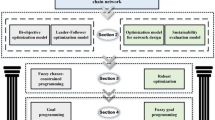Abstract
This paper deals with planning the product flows along a supply chain (SC) in which there are product losses in the nodes and in the arcs. Given the demand by each retailer, appropriate quantities to be procured from the different suppliers must be decided and the routing of the product along the SC must be determined. Care must be taken because, due to losses, the amount of product that will be finally available at the retailers is lower than the amount of product procured. The objective is twofold: minimizing total costs and minimizing product losses. The proposed approach leverages the existence of data on the flows in previous periods. With those observed flows, a Network Data Envelopment Analysis technology is inferred which allows the computing of any feasible operating point. The resulting biobjective optimization problem can be solved using the weighted Tchebycheff method.





Similar content being viewed by others
References
Alfonso, E., Kalenatic, D., & López, C. (2010). Modeling the synergy level in a vertical collaborative supply chain through the IMP interaction model and DEA framework. Annals of Operations Research, 181(1), 813–827.
Ahuja, R. K., Magnanti, T. L., & Orlin, J. B. (1993). Network flows: Theory, algorithms, and applications. Englewood Cliffs: Prentice Hall.
Azadi, A., Zoroufchi, K. H., & Farzipoor Saen, R. (2012). A combination of Russell model and neutral DEA for 3PL provider selection. International Journal of Productivity and Quality Management, 10(1), 25–39.
Bertsekas, D., & Tseng, P. (1988). Relaxation methods for minimum cost for ordinary and generalized network flow problems. Operations Research, 36, 93–114.
Chen, Y., Liang, L., & Yang, F. (2006). A DEA game model approach to supply chain efficiency. Annals of Operations Research, 145(1), 5–13.
Du, J., Liang, L., Chen, Y., & Bi, G. B. (2010). DEA-based production planning. Omega, 38(1), 105–112.
Fu, L. F., Meng, J., & Liu, Y. (2015). Evaluation of supply chain efficiency based on a novel network of data envelopment analysis model. International Journal of Bifurcation and Chaos, 25(11), 1540036.
Fukuyama, H., & Weber, W. L. (2010). A slacks-based inefficiency measure for a two-stage system with bad outputs. Omega, 38(5), 398–409.
Hatami-Marbini, A., Agrell, P. J., Tavana, M., & Khoshnevis, P. (2017). A flexible cross-efficiency fuzzy data envelopment analysis model for sustainable sourcing. Journal of Cleaner Production, 142, 2761–2779.
Izadikhah, M., Farzipoor Saen, R., & Ahmadi, K. (2017). How to assess sustainability of suppliers in volume discount context? A new data envelopment analysis approach. Transportation Research Part D, 51, 102–121.
Kao, C. (2014). Network data envelopment analysis: A review. European Journal of Operational Research, 239(1), 1–16.
Khalili-Damghani, K., & Tavana, M. (2013). A new fuzzy network data envelopment analysis model for measuring the performance of agility in supply chains. International Journal of Advanced Manufacturing Technology, 69, 291–318.
Khodakarami, M., Shabani, A., Farzipoor Saen, R., & Azadi, M. (2015). Developing distinctive two-stage data envelopment analysis models: An application in evaluating the sustainability of supply chain management. Measurement, 70, 62–74.
Liang, L., Yang, F., Cook, W. D., & Zhu, J. (2006). DEA models for supply chain efficiency evaluation. Annals of Operations Research, 145(1), 35–49.
Lozano, S. (2011). Scale and cost efficiency analysis of networks of processes. Expert Systems With Applications, 38(6), 6612–6617.
Lozano, S. (2014). Company-wide production planning using a multiple technology DEA approach. Journal of the Operational Research Society, 65, 723–734.
Lozano, S. (2015). Alternative SBM Model for Network DEA. Computers & Industrial Engineering, 82, 33–40.
Lozano, S., & Gutiérrez, E. (2016). Efficiency assessment and output maximization possibilities of European small and medium sized airports. Research in Transportation Economics, 56, 3–14.
Marler, R. T., & Arora, J. S. (2004). Survey of multi-objective optimization methods for engineering. Structural and Multidisciplinary Optimization, 26(6), 369–395.
Mirhedayatian, S. M., Azadi, M., & Farzipoor Saen, R. (2014). A novel network data envelopment analysis model for evaluating green supply chain management. International Journal of Production Economics, 147, 544–554.
Momeni, E., Azadi, M., & Farzipoor Saen, R. (2015). Measuring the efficiency of third party reverse logistics provider in supply chain by multi objective additive network DEA model. International Journal of Shipping and Transport Logistics, 7(1), 21–41.
Omrani, H., & Keshavarz, M. (2016). A performance evaluation model for supply chain of shipping company in Iran: an application of the relational network DEA. Maritime Policy and Management, 43(1), 121–135.
Omrani, H., Adabi, F., & Adabi, N. (2017). Designing an efficient supply chain network with uncertain data: A robust optimization–data envelopment analysis approach. Journal of the Operational Research Society. doi:10.1057/jors.2016.42.
Petridis, K., Dey, P. K., & Emrouznejad, A. (2016). A branch and efficiency algorithm for the optimal design of supply chain networks. Annals of Operations Research. doi:10.1007/s10479-016-2268-3.
Pourhejazy, P., Kwon, O. K., Chang, Y. T., & Park, H. K. (2017). Evaluating resiliency of supply chain network: A data envelopment analysis approach. Sustainability, 9, 255.
Shabani, A., Farzipoor Saen, R., & Torabipour, S. M. R. (2012). A new benchmarking approach in Cold Chain. Applied Mathematical Modelling, 36, 212–224.
Shafiee, M., Hosseinzadeh Lotfi, F., & Saleh, H. (2014). Supply chain performance evaluation with data envelopment analysis and balanced scorecard approach. Applied Mathematical Modelling, 38, 5092–5112.
Steuer, R. E. (1986). Multiple criteria optimization: Theory computation and application. New York: Wiley.
Steuer, R. E., & Choo, E. U. (1983). An interactive weighted Tchebycheff procedure for multiple objective programming. Mathematical Programming, 26, 326–344.
Tavana, M., Mirzagoltabar, H., Mirhedayatian, S. M., Farzipoor Saen, R., & Azadi, M. (2013). A new network epsilon-based DEA model for supply chain performance evaluation. Computers and Industrial Engineering, 66(2), 501–513.
Tavana, M., Kaviani, M. A., Di Caprio, D., & Rahpeyma, B. (2016). A two-stage data envelopment analysis model for measuring performance in three-level supply chains. Measurement, 78, 322–333.
Tone, K., & Tsutsui, M. (2009). Network DEA: A slacks-based measure approach. European Journal of Operational Research, 197, 243–252.
Wong, W. P., & Wong, K. Y. (2007). Supply chain performance measurement system using DEA modeling. Industrial Management & Data Systems, 107(3), 361–381.
Yang, F., Wu, D., Liang, J., Bi, G. & Wu, D. D. (2011). Supply chain DEA: production possibility set and performance evaluation model. Annals of Operations Research, 185, 195–211.
Zhou, Z., Wang, M., Ding, H., Ma, C. & Liu, W. (2013). Further study of production possibility set and performance evaluation model in supply chain DEA. Annals of Operations Research, 206, 585–592.
Acknowledgements
This research was carried out with the financial support of the Spanish Ministry of Science Grant DPI2013-41469-P and the European Regional Development Fund (ERDF).
Author information
Authors and Affiliations
Corresponding author
Rights and permissions
About this article
Cite this article
Lozano, S., Adenso-Diaz, B. Network DEA-based biobjective optimization of product flows in a supply chain. Ann Oper Res 264, 307–323 (2018). https://doi.org/10.1007/s10479-017-2653-6
Published:
Issue Date:
DOI: https://doi.org/10.1007/s10479-017-2653-6




